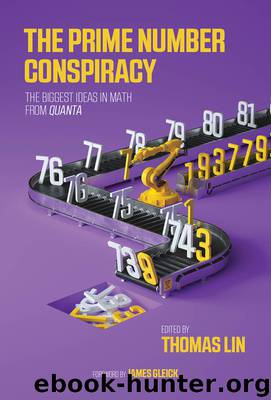The Prime Number Conspiracy by Thomas Lin

Author:Thomas Lin
Language: eng
Format: epub
Tags: Quanta Magazine; mathematics; computer science; prime numbers; infinity; Kevin Hartnett; Natalie Wolchover; Erica Klarreich, commentary, essays, math stories, math theory, mathematicians, math research
Publisher: The MIT Press
HARVARD
Gold medals at the mathematical Olympiad don’t always translate into success in mathematics research, said Curtis McMullen of Harvard University, who was Mirzakhani’s doctoral adviser. “In these contests, someone has carefully crafted a problem with a clever solution, but in research, maybe the problem doesn’t have a solution at all.” Unlike many Olympiad high-scorers, he said, Mirzakhani had “the ability to generate her own vision.”
After completing an undergraduate degree in mathematics at Sharif University of Technology in Tehran in 1999, Mirzakhani went to graduate school at Harvard University, where she started attending McMullen’s seminar. At first, she didn’t understand much of what he was talking about but was captivated by the beauty of the subject, hyperbolic geometry. She started going to McMullen’s office and peppering him with questions, scribbling down notes in Farsi.
“She had a sort of daring imagination,” recalled McMullen, a 1998 Fields medalist. “She would formulate in her mind an imaginary picture of what must be going on, then come to my office and describe it. At the end, she would turn to me and say, ‘Is it right?’ I was always very flattered that she thought I would know.”
Mirzakhani became fascinated with hyperbolic surfaces—doughnut-shaped surfaces with two or more holes that have a non-standard geometry which, roughly speaking, gives each point on the surface a saddle shape. Hyperbolic doughnuts can’t be constructed in ordinary space; they exist in an abstract sense, in which distances and angles are measured according to a particular set of equations. An imaginary creature living on a surface governed by such equations would experience each point as a saddle point.
It turns out that each many-holed doughnut can be given a hyperbolic structure in infinitely many ways—with fat doughnut rings, narrow ones or any combination of the two. In the century and a half since such hyperbolic surfaces were discovered, they have become some of the central objects in geometry, with connections to many branches of mathematics and even physics.
But when Mirzakhani started graduate school, some of the simplest questions about such surfaces were unanswered. One concerned straight lines, or “geodesics,” on a hyperbolic surface. Even a curved surface can have a notion of a “straight” line segment: it’s simply the shortest path between two points. On a hyperbolic surface, some geodesics are infinitely long, like straight lines in the plane, but others close up into a loop, like the great circles on a sphere.
The number of closed geodesics of a given length on a hyperbolic surface grows exponentially as the length of the geodesics grows. Most of these geodesics cut across themselves many times before closing up smoothly, but a tiny proportion of them, called “simple” geodesics, never intersect themselves. Simple geodesics are “the key object to unlocking the structure and geometry of the whole surface,” Farb said.
Yet mathematicians couldn’t pin down just how many simple closed geodesics of a given length a hyperbolic surface can have. Among closed geodesic loops, the simple ones are “miracles that [effectively] happen zero percent of the time,” Farb said.
Download
This site does not store any files on its server. We only index and link to content provided by other sites. Please contact the content providers to delete copyright contents if any and email us, we'll remove relevant links or contents immediately.
| Applied | Geometry & Topology |
| History | Infinity |
| Mathematical Analysis | Matrices |
| Number Systems | Popular & Elementary |
| Pure Mathematics | Reference |
| Research | Study & Teaching |
| Transformations | Trigonometry |
Modelling of Convective Heat and Mass Transfer in Rotating Flows by Igor V. Shevchuk(6391)
Weapons of Math Destruction by Cathy O'Neil(6142)
Factfulness: Ten Reasons We're Wrong About the World – and Why Things Are Better Than You Think by Hans Rosling(4694)
Descartes' Error by Antonio Damasio(3230)
A Mind For Numbers: How to Excel at Math and Science (Even If You Flunked Algebra) by Barbara Oakley(3217)
Factfulness_Ten Reasons We're Wrong About the World_and Why Things Are Better Than You Think by Hans Rosling(3199)
TCP IP by Todd Lammle(3134)
Fooled by Randomness: The Hidden Role of Chance in Life and in the Markets by Nassim Nicholas Taleb(3044)
Applied Predictive Modeling by Max Kuhn & Kjell Johnson(3018)
The Tyranny of Metrics by Jerry Z. Muller(3000)
The Book of Numbers by Peter Bentley(2910)
The Great Unknown by Marcus du Sautoy(2646)
Once Upon an Algorithm by Martin Erwig(2598)
Easy Algebra Step-by-Step by Sandra Luna McCune(2583)
Lady Luck by Kristen Ashley(2532)
Practical Guide To Principal Component Methods in R (Multivariate Analysis Book 2) by Alboukadel Kassambara(2497)
Police Exams Prep 2018-2019 by Kaplan Test Prep(2484)
All Things Reconsidered by Bill Thompson III(2355)
Linear Time-Invariant Systems, Behaviors and Modules by Ulrich Oberst & Martin Scheicher & Ingrid Scheicher(2333)
